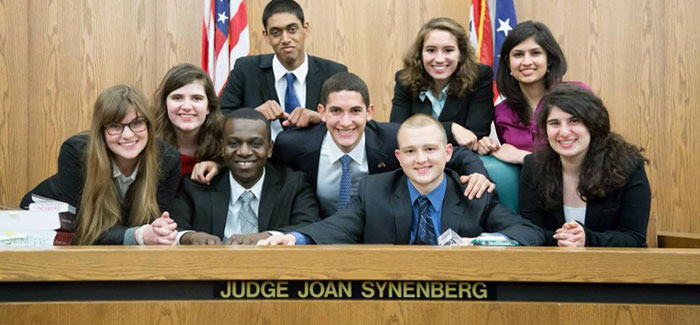
Vandervalk’s mock trial team at a tournament last year. (Photography by Peter X. Tang)
Thirty-six students dress up as lawyers and witnesses for a mock trial tournament at Eastern Michigan University.
May it please the court, opposing counsel, members of the jury.
Sometimes, I like to dress up and pretend to be a lawyer.
At 3 p.m. on a Friday in early November, 36 members of the UChicago mock trial team pack the Reynolds Club. We get bagels for the road and head into our Zipcars. It’s a four-hour drive to Eastern Michigan University—four hours spent singing many rousing renditions of “I’ll Make a Man Out of You” from the Disney movie Mulan, memorizing speeches under our breath, and retelling old mock lore for the new members (like the time that Joey said “May I please the court?” instead of “May it please the court?”).
[[{"type":"media","view_mode":"media_original","fid":"2196","attributes":{"alt":"","class":"media-image","height":"333","typeof":"foaf:Image","width":"460"}}]]
Students from UChicago’s mock trial program gather to take a group photo at the end of the Eastern Michigan University tournament. (Photography by Kiran Misra)
After tanking theater auditions my first quarter freshman year, I decided to try out for mock trial. Since then I’ve been to nine different tournaments, played two different witness characters, and given three different closing speeches. Logistically, mock trial is both complicated and stressful. Most schools have more than one team, and UChicago has four competing teams for most of the season. Every year the American Mock Trial Association (AMTA) creates either a civil or criminal case problem. They provide each team with a set of laws and precedents for a place called Midlands, the fictional US state where mock trial takes place. They also provide affidavits of witnesses whom each team is allowed to call to the stand. These characters can be anyone from eyewitnesses to police officers to doctors who testified about their medical findings. Some students act as witnesses, while others act as lawyers.
Mock trial is the child of debate and theater. In a nutshell, it’s students acting out an episode of Law & Order.
During the trial itself, one lawyer from each team gives a five-minute opening speech, and then the witnesses are called to the stand. Each is subject to a direct examination by a member of their own team (a chance for the witnesses to tell their story) and a cross examination by a member of the opposing team (a chance for the attorney to discredit the witness). At the end of the trial, someone from each team delivers a dramatic, nine-minute closing argument. It’s the closing attorney’s job to put the pieces of evidence into a story and convince the jury that their side of the case is more likely to be true.
This year’s mock trial problem is a civil case about Jesse Duran, an 11-year-old kid who shot Sydney Park, another child. The plaintiff could choose to contend either that Duran shot Park intentionally because Duran is a psychopath or that Duran’s parent failed to warn him about the dangers of guns, and his parent is liable under the law. At the Eastern Michigan University tournament, I was the closing attorney for the plaintiff, and my team chose the former.
A clip from my closing:
When Andy Park went to work on August 18, she thought it would just be a regular day until she got a call that changed everything. The voice on the other line said, “There was an incident at your home.” They wouldn’t tell her anything else. She drove home frantically, but nothing she could think of was as bad as what she found. When she got home, she saw her daughter on the ground. Only her pink flip-flops peeked out from underneath the sheet that covered her body. Her daughter was dead.
Andy Park didn’t know how this could have happened.
She didn’t know that Jesse Duran had found the Park family gun, and found the combination to its safe. That Jesse Duran had loaded the gun, aimed it, fired it while Sydney wasn’t even looking. She didn’t know that Jesse Duran sat on the couch and watched her daughter die. Andy Park didn’t know that Jesse Duran was a psychopath. But now, we do know.
Because it isn’t a real trial but instead a contest, judges score each member of the team on a scale of 1-10, and the team with the highest score at the end of the trial wins the round. Each tournament consists of four rounds, and the team with the most winning rounds wins the tournament. About 25 teams enter every tournament, and in the tournament this past November, my team placed fourth (after getting knocked out of first place by last year’s national champions from UCLA). Another UChicago team placed second. We took home six individual awards from that tournament, but this is only the beginning of our season. We have four more tournaments to go before you’ll see us at nationals in Cincinnati this spring.
